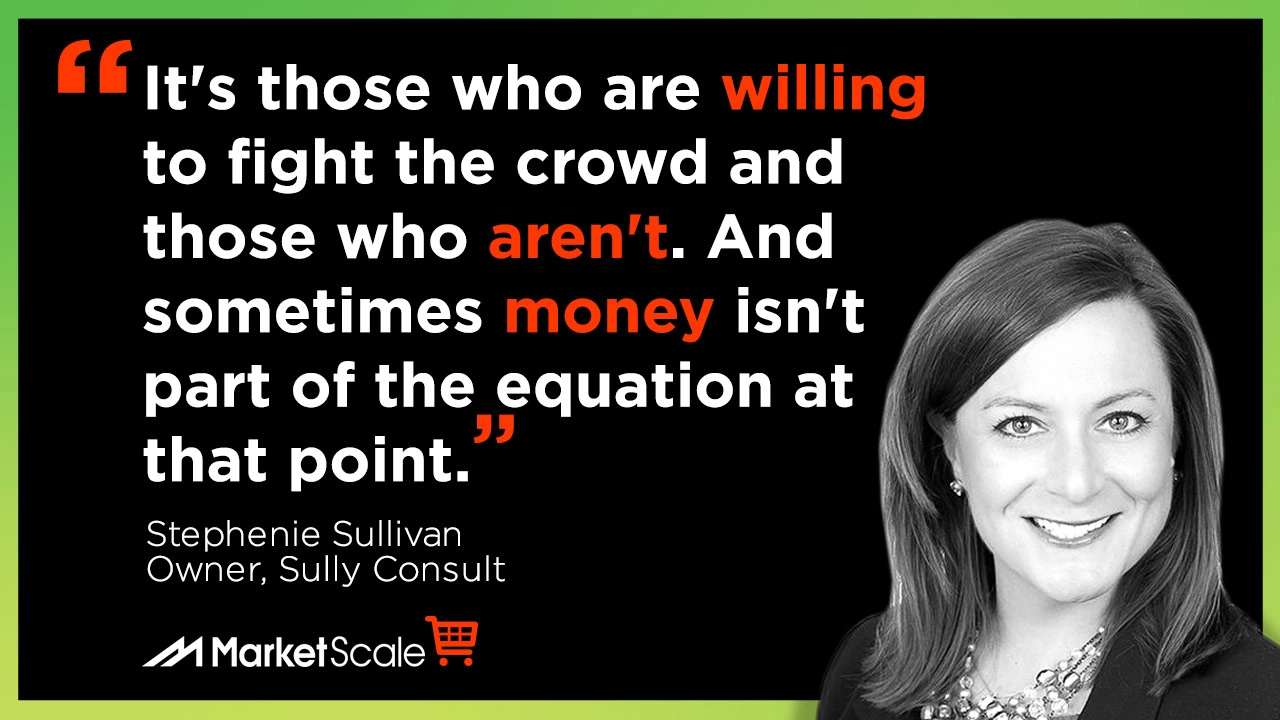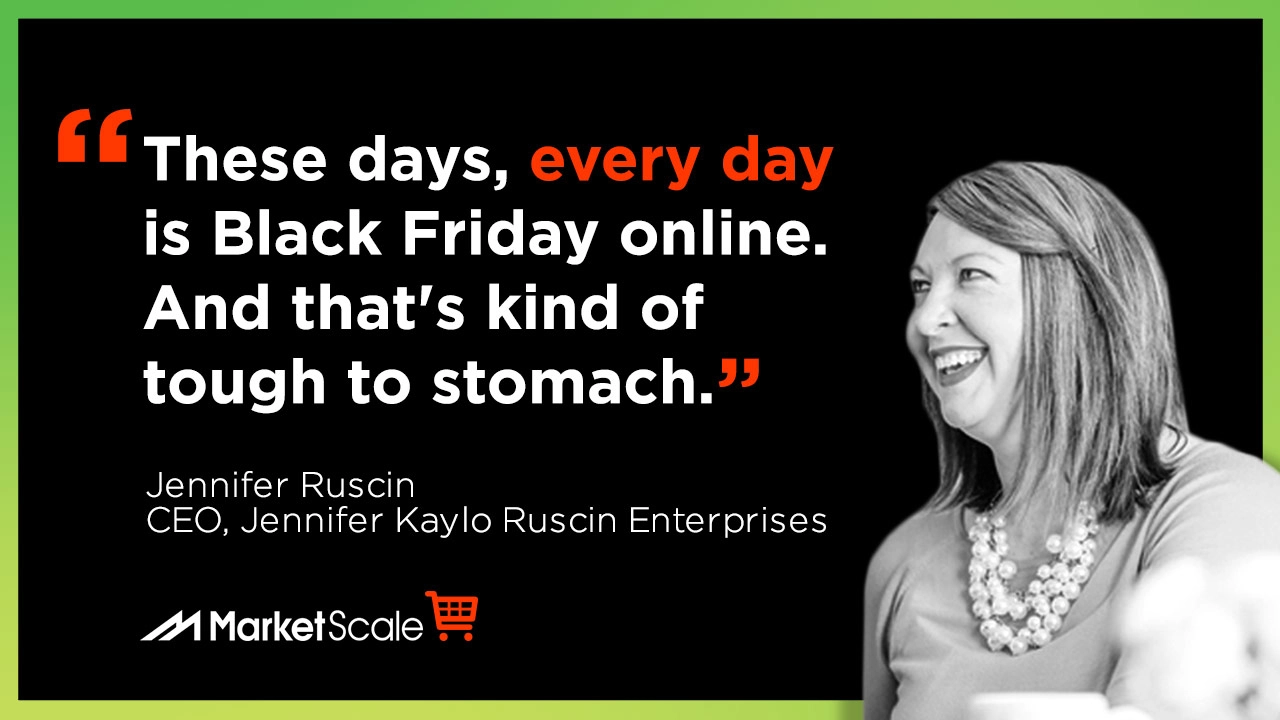Retail Experts Discuss Black Friday and How it has Evolved
This is The MarketScale Retail Show, hosted by Daniel Litwin, the Voice of B2B. Your weekly B2B kick-back for the best thought leadership in the industry, bringing you education, information and inspiration.
On today’s episode of the MarketScale Retail Show, we’re looking at Black Friday 2018. Things have changed over the last few years in Retail, and Black Friday hasn’t been left out. With industry giants like Amazon overtaking e-commerce, consumers have found year-round ways to save money. With Black Friday losing it’s intrigue, what is a shopper looking for, and how should brick-and-mortar stores attract customers into their stores? We have all that in more, with two features from branding experts in Retail; Jennifer Ruscin, CEO and Owner of Jennifer Kaylo Ruscin Enterprises, explains best practices for staying profitable in a season that demands deals, and Stephenie Sullivan, Owner of Sully Consult, helps us define the Black Friday shopper of today, and what it will take to get them engaged.
DEFINING THE BLACK FRIDAY SHOPPER
 There are typically two kinds of in-store Black Friday shoppers. On one hand you have the budget hunters; this shopper is gearing up for the holiday season and has gifts galore to compile, so Black Friday is the perfect place to secure real deals on a tight budget. On the other hand, you have the thrill seekers; this shopper gets a kick of adrenaline running through store front doors at opening, living for the event of the crowds and the bargain search.
There are typically two kinds of in-store Black Friday shoppers. On one hand you have the budget hunters; this shopper is gearing up for the holiday season and has gifts galore to compile, so Black Friday is the perfect place to secure real deals on a tight budget. On the other hand, you have the thrill seekers; this shopper gets a kick of adrenaline running through store front doors at opening, living for the event of the crowds and the bargain search.
In 2018, your traditional Black Friday shopper has evolved. “The shopper over the years has become more savvy, they’ve learned they can now shop the best deals, not just take the retailer for their word,” Stephenie Sullivan, Owner of Sully Consult, told us on our podcast. Sullivan, who was worked in strategic brand positioning for Walmart and traditional grocery over the last 16 years, remembers when Black Friday used to be the bargain event of the year; now, it’s losing its intrigue. This is forcing retailers to be creative and find non-financial ways to attract this new-age shopper. “A lot of retailers are finding customer service, they’re looking at item exclusivity,” Sullivan said.
Sullivan breaks down some specific examples of how retailers are adapting to the 2018 Black Friday shopper, and explains that even as online deals remove some of the budget power from Black Friday, people that want to be out that day won’t be dissuaded by easy deals. “When you’re looking for the thrill seeking side of it, you want to be where you’re gonna get the most action and feel like you’ve conquered the biggest mountain,” Sullivan said.
HOW RETAILERS ARE ADAPTING TO BLACK FRIDAY EVERY DAY
 Jennifer Ruscin, CEO and Owner of Jennifer Kaylo Ruscin Enterprises, made a bold claim on our podcast. “These days, every day is Black Friday online. And that’s kind of tough to stomach.” She’s not wrong. Amazon and other e-commerce giants are revolutionizing deals, and customers know where to find them any time of the year. That doesn’t mean shoppers don’t want to partake in Black Friday; consumer confidence is at an all-time high according to Bloomberg News. “Median wages are on the rise, households are wealthier thanks to continued gains in the stock market,” Ruscin said, which could make this the best Christmas shopping season in recent memory. And yet, retailers are still worried. How do you convert that consumer confidence into feet at your store?
Jennifer Ruscin, CEO and Owner of Jennifer Kaylo Ruscin Enterprises, made a bold claim on our podcast. “These days, every day is Black Friday online. And that’s kind of tough to stomach.” She’s not wrong. Amazon and other e-commerce giants are revolutionizing deals, and customers know where to find them any time of the year. That doesn’t mean shoppers don’t want to partake in Black Friday; consumer confidence is at an all-time high according to Bloomberg News. “Median wages are on the rise, households are wealthier thanks to continued gains in the stock market,” Ruscin said, which could make this the best Christmas shopping season in recent memory. And yet, retailers are still worried. How do you convert that consumer confidence into feet at your store?
Walmart, for example, is going above and beyond to get people into their stores. The retail giant is hosting 19,000 in-store events to let shoppers test out toys and tech, as well as launching a digital toy lab so kids can play with their toys in virtual simulations. “You can see Walmart is saying ‘hey, we’re not Amazon, but we are certainly also going to take our in-store experience and relay that back in a digital way,'” Ruscin said. She dives into the hottest buying trends for 2018’s Black Friday, as well as lists out six best practice tips for how retailers can stay profitable during a season expectation of low prices.
OTHER ARTICLES REFERENCED
- Target and other retailers take beating on Wall Street, despite rosy holiday forecasts
- Google adds live local stock data to searches to help drive shoppers into stores
- How Fashion Retailers can Make Black Friday Happy Friday
For the latest news, videos, and podcasts in the Retail Industry, be sure to subscribe to our industry publication.
Follow us on social media for the latest updates in B2B!
Twitter – @RetailMKSL
Facebook – facebook.com/marketscale
LinkedIn – linkedin.com/company/marketscale








